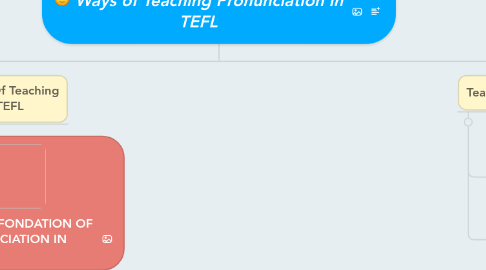
1. Ways Of Teaching Prosodic Features
1.1. TEACHING ENGLISH CONSONANTS
1.1.1. The contribution of such a personality as Dumitru Chitoranu in teachingEnglish sound cannot be omitted in any case. We find in his studies manystatements about English consonants .
1.1.2. There are 24 consonant sounds
1.1.2.1. We can classify the consonantsaccording to the manner of articulation as follows:
1.1.2.1.1. •Stop consonants [p, b, t , d, k, g] •Fricative consonants [ f, v,θ,ð, s, z,∫,, h] •Affricate consonants [,Ξ] • Nasal consonants [ m , n,ɳ ] •Liquid consonants [ l, r ] •Glide consonants [ w , j ]
1.1.3. Except this classification consonants have one more classification , that meansaccording to the functions of speech organs which are involved in their articulation
1.1.3.1. •Bilabial [ p, b , m ,w] •Labiodentals [ f, v ] •Dental [θ,ð] •Alveolar [ t, d, s, z, n, l ] •Palatal [∫,ʒ ,,Ξ,r , j ] •Velar [ k, g,ɳ ] •Glottal [ h ]
1.1.3.2. •Bilabial [ p, b , m ,w] •Labiodentals [ f, v ] •Dental [θ,ð] •Alveolar [ t, d, s, z, n, l ] •Palatal [∫,ʒ ,,Ξ,, j ] •Velar [ k, g,ɳ ] •Glottal [ h ]
1.1.4. And there is one more classification of the consonants – according to thecriteria of vibration of the cord
1.1.4.1. •Voiced [ b, d , g ,ð , v , ʒ , z,Ξ,m , n, l, r,w, j ] •Voiceless [ p, t, k,θ , f , ∫ , s, , h ]
1.1.4.2. •Voiced [ b, d , g ,ð , v , ʒ , z,Ξ,m , n, l, r,w, j ] •Voiceless [ p, t, k,θ , f , ∫ , s, , h ]
2. Theoretical Foundation Of Teaching English Pronunciation In TEFL
2.1. THEORETICAL FONDATION OF TEACHING PRONUNCIATION IN TEFL
2.1.1. pronunciation - the way in which alanguage or a particular word or sound is pronounced and secondly it is theway in which a particular person pronounces the words of a givenlanguage , in our case , the words of English
2.1.1.1. Pronunciation
2.1.1.1.1. two aspects of pronunciation
2.1.2. It is very important to mention the opinion of Marianne Celce-Murcia andJanet M. Godwin concerning difficulties in teaching English pronunciation . Theysay that there have been many differences of opinion over the years in the languageteaching pronunciation and about how best to teach it. In direct approaches pronunciation is very important but the methodology is primitive : the teacher isideally a native or near native speaker of the target language who presents pronunciation inductively and corrects via modeling – listen and imitate me as bestas you can
2.2. Micro-skills In Teaching English Pronunciation
2.2.1. Referring to micro-skills in teaching pronunciation , professor Jeremy Harmer tries to give an answer to such questions ‘What a native speaker knows ? ‘and‘What a language student should learn ?’.Well , native speakers or even competentusers of the language know how to say a word, that is how to pronounce it .Thisknowledge comprises three areas : sounds , stress and intonation.
2.3. Techniques Used In Teaching English Pronunciation
2.3.1. Different teachers who have studied this topic say that there are a lot of waysand of techniques used in teaching pronunciation . For example such teachers asBalbina Ebong and Martha Sabbadine from the British Council decided that agood method in teaching pronunciation is using songs .
2.3.1.1. https://www.youtube.com/watch?v=fxUdWV-mkQU&list=PLC329BBFC177807DE&index=7
2.3.2. There is another opinion of David F. Dalton , that exercise is good in training pronunciation. It should be simple , accessible , fun and combine reception and production
2.3.3. Celce Murcia and Godwin suggest us several techniques in teaching pronunciation . First there is “ listen and imitate/repeat” technique which was usedin direct approaches and also the audio-lingual approach . Second there are tongue-twisters
2.3.4. Another wonderful technique in teaching pronunciation is using a tape – recorder . We may find it useful to tape pronunciation listening exercises for our learners
3. Teaching English Sounds
3.1. Celce Murcia and Godwin in “Teaching Pronunciation “ help us a lot byinforming that English has 24 distinct consonant sounds that we can describe interms of their place and manner of articulation and in terms of voicing – whether the vocal cords are vibrating
3.2. Teachers as Tim Bowen and Jonathan Marks have something about teachingsounds. They consider important to pay attention to the whole process of pronunciation . Speaking about the vowels and diphthongs they point first to theair , voicing , jaw , lips ,tongue to every little detail.
4. Pronunciation
4.1. The English liquid sounds are [l]and [r]. [l] is pronounced by pushing the blade of the tongue on the alveolar ridge and the air must pass freely on the lateral parts of the tongue .[r] is pronounced by raising the blade of the tongue to the hard palate without touching this area of the palate . The liquid consonants appear ininitial , mid and final position
4.1.1. Pronunciation of the Liquid Consonants
4.2. Pronunciation Of The Glottal Consonants
4.2.1. Two English sounds resemble vowels and consonants at the same time. Theyare called semi vocals or semi consonants. As vowels they cannot form any syllableand as consonants they are always followed by a vowel . These are [j] and [w]

